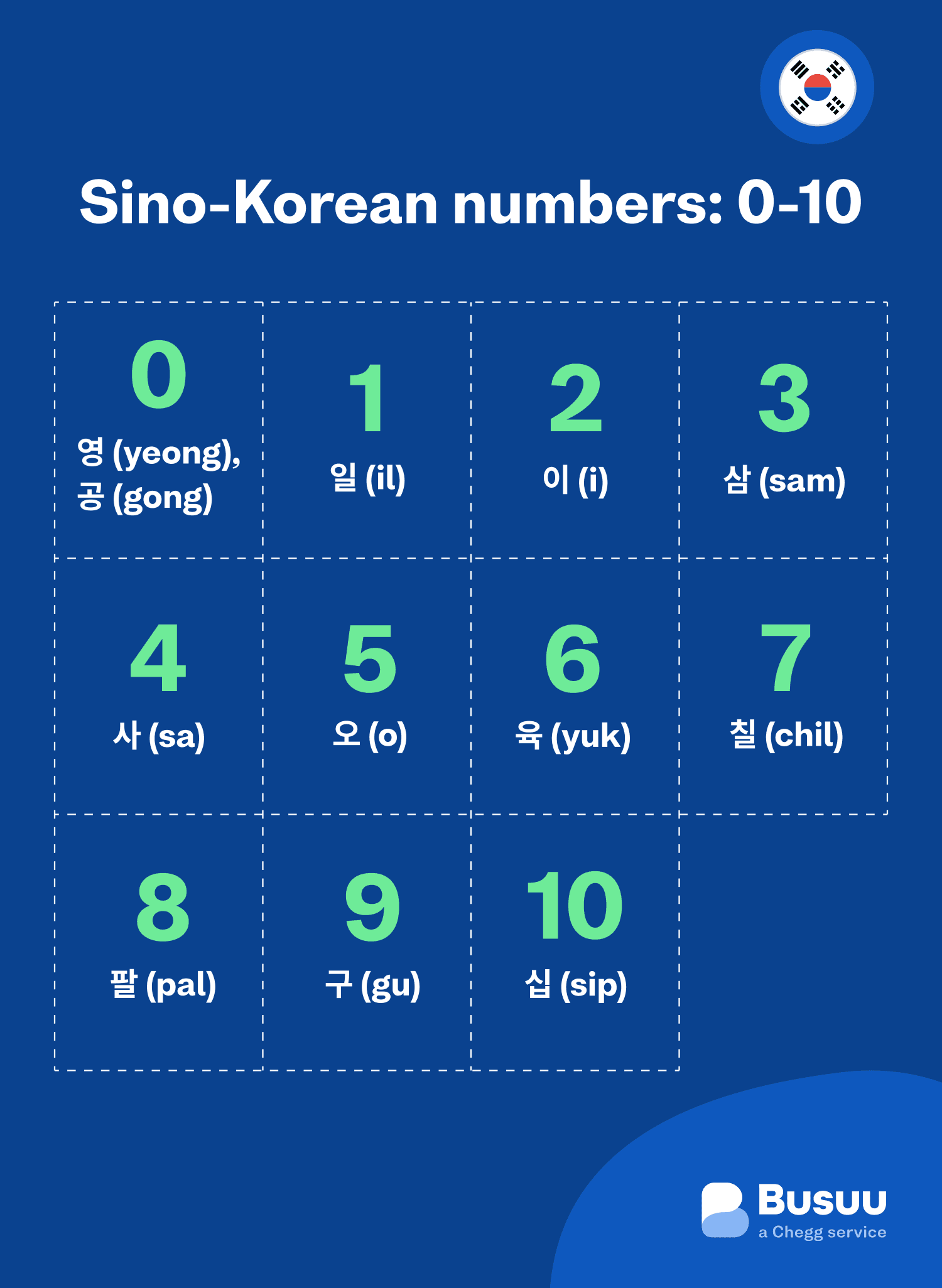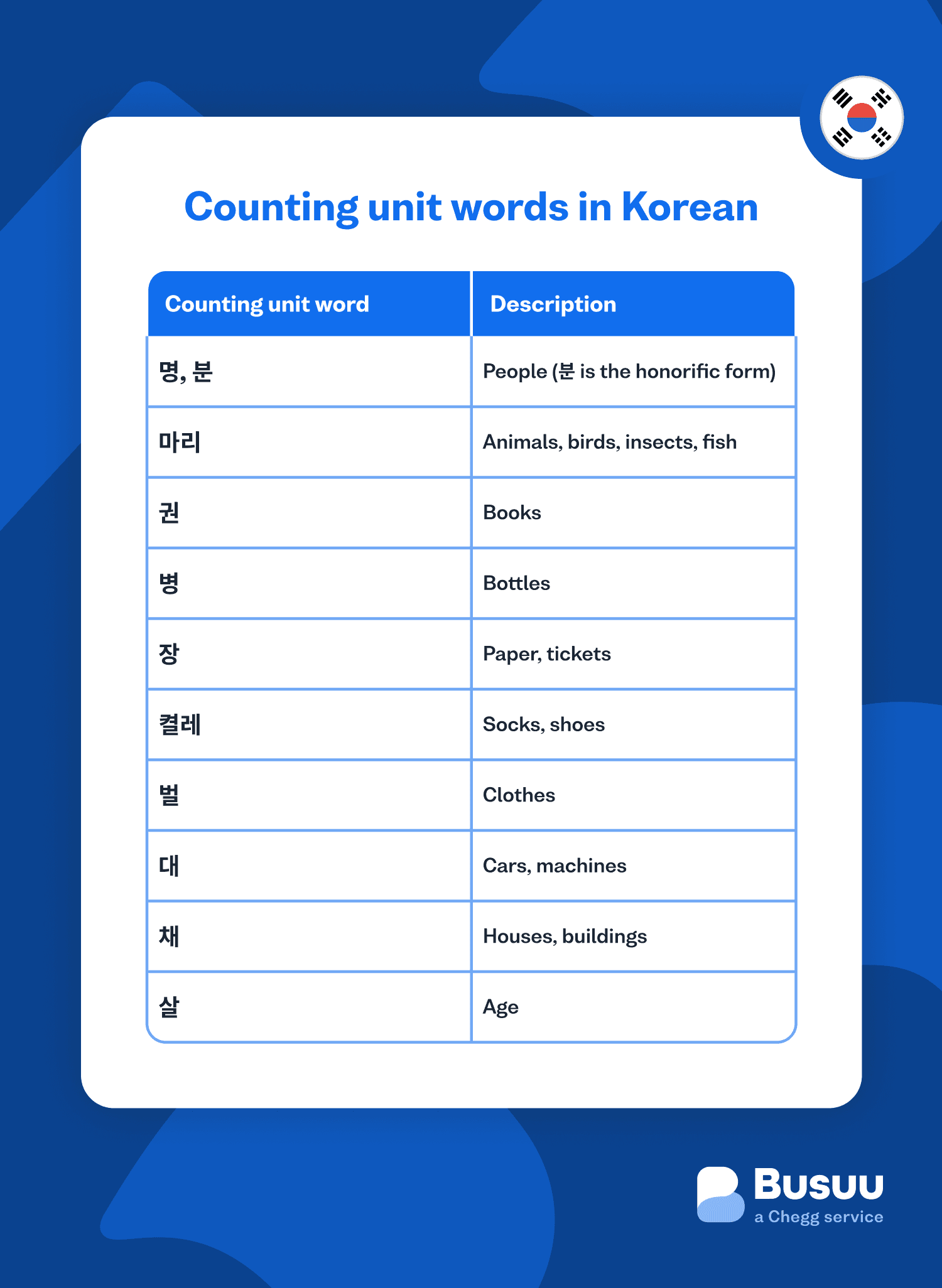I want to learn...
Learning numbers in any language is always a bit challenging, but Korean numbers are kind of… twice as hard. This is because in Korean, there are two sets of numbers: Sino-Korean numbers and Native Korean numbers.
Each number system has its own specific uses, so it’s important to learn both number systems. In this article, we will guide you through each number system and we will also explain how the two number systems are used. By the end of this article, you will have a complete understanding of numbers in Korean.
Let’s begin with Sino-Korean numbers.

Sino-Korean number: 0 to 10
Of the two number systems, Sino-Korean numbers are easier to learn, and the key to learn the Sino-Korean numbers is mastering the numbers 0 to 10.
0- 영 (yeong), 공 (gong)1- 일 (il)2- 이 (i)3- 삼 (sam)4- 사 (sa)5- 오 (o)6- 육 (yuk)7- 칠 (chil)8- 팔 (pal)9- 구 (gu)10- 십 (sip)
The two zeros have specific uses, and in general, 영 is more common of the two. However, we use 공 when talking about numbers in codes, such as telephone numbers and pin numbers, and to say the number for James Bond ‘007’, we say 공공칠.
Use of 영 and 공
1. 영 (yeong)
To talk about temperature: 영도 - 0 degree
To talk about math: 영점오 - 0.5
To talk about scores: 이 대 영 - 2-0
2. 공 (gong)
To talk about phone numbers: 010-2058… - 공일공 이공오팔
To talk about pin numbers: 0202 - 공이공이
Sino-Korean number: 11 to 99
To form numbers from 11 to 99, we just use the numbers from 1 to 10. First, to form the numbers from 11 to 19, we combine the word for 10 and a single digit number word, so to say 11, we combine 십 (10) and 일 (1) and say 십일 (11).
13- 십삼 (sip-sam)15- 십오 (sip-o)19- 십구 (sip-gu)
To form double digit number words ending in 0, such as 20 and 30, we combine a single digit number word and the word for 10, so to say 20, we combine 이 (2) and 십 (10) and say 이십 (20).
30- 삼십 (sam-sip)60- 육십 (yuk-sip)70- 칠십 (chil-sip)
Lastly, to form any number up to 99, we combine the word for numbers like 20 and 30 and a single digit number word, so to say 23, we combine 이십 (20) and 삼 (3) and say 이십삼 (23).
47- 사십칠 (sa-sip-chil)59- 오십구 (o-sip-gu)82- 팔십이 (pal-sip-i)
Sino-Korean number: 100 & 1,000
Korean word for 100 is 백 (baek) and to form any number in the hundred range, we combine the words for 1 to 10 with 백. For example, to say 300, we combine 삼 (3) and 백 (100) and say 삼백. Additionally, to say 355, we combine 삼백 (300) and 오십오 (55), and say 삼백오십오 (355). One thing to note is that to say the number 100, we usually don’t say 일백 (one hundred), we just say 백 (hundred).
500- 오백 (o-baek)560- 오백육십 (o-baek-yuk-sip)568- 오백육십팔 (o-baek-yuk-sip-pal)
1,000 in Korean is 천 (cheon), and similar to 백, to form any number in the thousand range, we combine the words for 1 to 10 with 천. For example, to say 3,000, we combine 삼 (3) and 천 (1,000) and say 삼천 (3,000). Additionally, to say 3,550, we combine 삼천 (300) and 오백오십 (550), and say 삼천오백오십 (3,550). Similar to 100, to say 1,000, we usually don’t say 일천 (one thousand), we say 천 (thousand).
5,000- 오천 (o-cheon)5,650- 오천육백오십 (o-cheon-yuk-baek-o-sip)5,658- 오천육백오십팔 (o-cheon-yuk-baek-o-sip-pal)
Sino-Korean number: 10,000
To say 10,000, we use the word 만 (man), and like the other number words we have learned, we combine 만 with the numbers 1 to 10, and also 백 (100) and 천 (1,000) to form large numbers above 10,000. For example, to say 30,000, we combine 삼 (3) and 만 (10,000) and say 삼만, and to say 35,000, we combine 삼만 (30,000) and 오천 (5,000) and say 삼만오천 (35,000).
20,000- 이만 (i-man)26,000- 이만육천 (i-man-yuk-cheon)26,300- 이만육천삼백 (i-man-yuk-cheon-sam-baek)
To say bigger numbers, we add bigger number phrases in front of 만. So to say 250,000, we have to think about how many 만 there are in 250,000. In 250,000, there are 25 만, so we combine 이십오 (25) and 만 (10,000) and say 이십오만 (250,000).
100,000- 십만 (sip-man)1,000,000- 백만 (baek-man)10,000,000- 천만 (cheon-man)25,500,000- 이천오백오십만 (i-cheon-o-baek-o-sip-man)
Now, you might be wondering - is it really necessary to learn how to say such large numbers in Korean? The simple answer is “yes”. One of the main uses of Sino-Korean numbers is to talk about money, and Korean currency, 원 (won), works in large numbers. 1,100 won is about 1 US dollar, so a new coat can cost 십만원 (100,000 won/$100), and a flight to Seoul can cost 백만원 (1,000,000 won/$1,000) depending on where you’re flying in from.
Therefore, you must learn how to say such large numbers in Korean.
Hundred million and above
The next number word after 만 is 억 (eok), and 억 means 100,000,000. In general, use of 억 is not very common, though you would use 억 if you were looking to buy a property in Seoul. Forming numbers using 억 is the same as other number words. We combine 억 with number words for 1 to 10, 100, and 1000. For example, to say 200,000,000, we combine 이 (2) and 억 (100,000,000) and say 이억 (200,000,000).
300,000,000- 삼억 (sam-eok)370,000,000- 삼억칠천만 (sam-eok-chil-cheon-man)376,000,000- 삼억칠천육백만 (sam-eok-chil-cheon-yuk-baek-man)
The next big number word is 조 (jo) and this means 1,000,000,000,000, but this word is rarely used in everyday Korean.
Native Korean number: 1 to 10
Native Korean numbers do not include zero, and they are only used up to 99, so in some ways, it’s a little easier to learn. Below are the numbers 1 to 10.
1- 하나 (ha-na)2- 둘 (dul)3- 셋 (set)4- 넷 (net)5- 다섯 (da-seot)6- 여섯 (yeo-seot)7- 일곱 (il-gop)8- 여덟 (yeo-deol)9- 아홉 (a-hop)10- 열 (yeol)
Native Korean number: 11 to 99
Unlike Sino-Korean numbers, we have specific words for numbers ending in zero.
20- 스물 (seu-mul)30- 서른 (seo-reun)40- 마흔 (ma-heun)50- 쉰 (swin)60- 예순 (ye-sun)70- 일흔 (il-heun)80- 여든 (yeo-deun)90- 아흔 (a-heun)
So to say numbers up to 99, we simply combine the words for numbers ending in zero with a single digit number word. For example, to say 11, we combine 열 (10) and 하나 (1) and say 열하나 (11). Also, to say 35, we combine 서른 (30) and 다섯 (5) and say 서른다섯 (35).
34- 서른넷 (seo-reun-net)52- 쉰둘 (swin-dul)68- 예순여덟 (ye-sun-yeo-deol)91- 아흔하나 (a-heun-ha-na)
How to use Sino-Korean numbers
We mainly use Sino-Korean numbers to talk about the following:
1. To talk about money
Example: 50,000 won - 오만원 (o-man-won)
2. To talk about the date
Example: January 1st - 일월 일일 (il-wol il-il)
3. To talk about phone numbers
Example: 123-4567 - 일이삼-사오육칠 (il-i-sam sa-o-yuk-chil)
4. To count days, months, and years
Examples:
1 day - 일일 (il-il)
1 month - 일 개월 (il gae-wol)
1 year - 일 년 (il nyeon)
Pronunciation of 육 (yuk)
Pronunciation of 육 can vary depending on the position of 육 in the phrase and other sounds nearby.
6 is pronounced as 육 (yuk) when the it’s the first syllable of a phrase. For example, if someone’s phone number begins with 645, we pronounce this as 육사오 (yuk-sa-o).
6 is pronounced as 륙 (ryuk) when 6 comes after a vowel or the final consonant ㄹ. For example, if someone’s phone number begins with 246 (이사육), 육 comes after the vowel ㅏ, so we pronounce this as 이사륙.
246(이사륙)963(구륙삼)586(오팔륙)
6 is pronounced as 뉵 (nyuk) when 6 comes after a final consonant other than ㄹ. For example, if someone’s phone number begins with 506 (오공육), 육 comes after the final consonant ㅇ, so we pronounce this as 오공뉵.
836(팔삼뉵)606(육공뉵)26(이심뉵)
When we say 26, not only is 육 (yuk) pronounced as 뉵 (nyuk), 십 (sip) is also pronounced as 심 (sim), so 26 is pronounced as 이심뉵.
36- (삼심뉵)56- (오심뉵)
How to use native Korean numbers
The main use of native Korean numbers is to count things, so to say phrases like ‘one pen’, ‘two cars’, and ‘three books’, we use Native Korean numbers rather than Sino-Korean numbers.
one pen- 펜 한 개 (pen han gae)
To say ‘one pen’, we say the object 펜 (pen), and then the number word 한 (1), and then we use a counting unit word 개.
When we count using native Korean numbers, we contract the numbers 1, 2, 3, 4, and 20.
1- 하나 → 한2- 둘 → 두3- 셋 → 세4- 넷 → 네20- 스물 → 스무
However, although we contract 스물 to 스무, if the number is 21, we only contract the last number word, and not 스물. So 21 is 스물한, and not 스무한.
Korean language has many counting unit words, and we use 개 to count inanimate objects, such as a pen or a bag. However, there are many other counting unit words in Korean.

Common counting unit words in Korean
| Counting unit word | Description |
|---|---|
| 명, 분 | people (분 is the honorific form) |
| 마리 | animals, birds, insects, fish |
| 권 | books |
| 병 | bottles |
| 장 | paper, tickets |
| 켤레 | socks, shoes |
| 벌 | clothes |
| 대 | cars, machines |
| 채 | houses, buildings |
| 살 | age |
When we use these counting unit words, we can just say a number word and the counting unit word, so to say one person, we can just say 한 명 (han myeong), but we can also add nouns in front of this phrase to refer to specific kinds of people. So we can say 남자 한 명 (nam-ja han myeong) to mean ‘one man’, and 여자 한 명 (yeo-ja han myeong) to mean ‘one woman’.
1 student -학생 한 명 (hak-saeng han myeong)2 dogs -개 두 마리 (gae du ma-ri)4 books- 책 네 권 (chaek ne gwon)3 cars- 차 세 대 (cha se dae)
Some exceptions for Korean numbers
1. Telling the time
One of the exceptions is when we tell the time. To tell the time, we use the words 시 (hour) and 분 (minute), and we use number words in front of these words to say the hour and the minute. Here’s an example phrase:
1:10- 한 시 십 분 (han si sip bun)
To say the hour, we use Native Korean numbers, and to say the minute, we use Sino-Korean numbers, so to tell the time, we use both number systems.
10:20- 열 시 이십 분 (yeol si i-sip bun)7:30- 일곱 시 삼십 분 (il-gop si sam-sip bun)2:50- 두 시 오십 분 (du si o-sip bun)
2. Counting with Sino-Korean numbers
While the most common way of counting things is to use Native Korean numbers, there are also instances where we use Sino-Korean numbers to count things in Korean. For example, when we order food in portions in Korean, we can use the word 인분 (in-bun), which means portion with Sino-Korean numbers, so to ask for one portion, we say 일 인분 (il in-bun) and not 한 인분.
When we count things in Sino-Korean numbers, we use a different counting unit word and the counting unit word is often rooted in Chinese languages. However, many counting unit words used with Native Korean numbers are also rooted in the Chinese language.
Lastly, as we mentioned before, we tend to use Native Korean numbers to count months and years. However, we can use Sino-Korean numbers to count days, months, and years - but with different counting unit words.
3. Counting days, months, years in Korean
1 day- There is no Native Korean number for 1 day but there is a Sino Korean number and that is 일 일.
1 month- The Native Korean number is 한 달 and the Sino-Korean number is 일 개월.
1 year- The Native Korean number is 한 해 and the Sino-Korean number is 일 년.
Counting months using the counting unit word 달 (dal) is very common, and while 해 (hae) is commonly used with 한 to refer to 1 year, it’s not as common to use 해 with other number words in Korean.
Additionally, there are also Native Korean phrases to count days, but rather than the phrases being made up of a number word and a counting unit word, they are individual phrases on their own.
1 day- 하루 (ha-ru)2 days- 이틀 (i-teul)3 days- 사흘 (sa-heul)4 days- 나흘 (na-heul)5 days- 닷새 (dat-sae)6 days- 엿새 (yeot-sae)7 days- 이레 (i-re)
And while the phrases for ‘1 day’ and ‘2 days’ are commonly used, other phrases are less common in everyday life.
Korean numbers: Wrapping up
One of the first things we do when learning a new language is to learn the numbers, and like many aspects of language learning, once you have learned the basic concept, you have to practice using the numbers.
As we have seen in this article, we use each number system in specific contexts, so to ask the price of things, we use Sino-Korean numbers, and if we want to ask for two pens in a stationery store, we need to use Native Korean numbers. To practice using Korean, head over to the Busuu app where you will get to use Korean numbers in many different situations, and along the way, you will naturally learn useful Korean expressions and develop your understanding of Korean numbers.
AUTHOR

Keehwan Kim
Newlanguages


